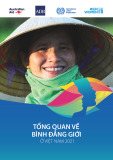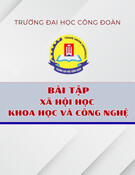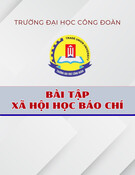
TNU Journal of Science and Technology
229(03): 03 - 11
http://jst.tnu.edu.vn 3 Email: jst@tnu.edu.vn
THE STATUS OF ACCESSING TO INFORMATION ON GENDER EQUALITY
IN ETHNIC MINORITY COMMUNITIES IN THAI NGUYEN PROVINCE
Bui Thi Huong Giang*, Tran Van Dien, Nguyen Huu Tho, Nguyen Thi Thuy Chi
Dang Quang Huy, Nguyen Thi Hai Yen, Vu Thi Quynh
TNU - Women from Ethnic Minorities and Mountainous Areas Research and Development Center
ARTICLE INFO
ABSTRACT
Received:
22/02/2023
This study aims to assess the current status of accessing to information
on gender equality in ethnic minority areas in Thai Nguyen province;
thereby proposing solutions to improve people’s awareness of this issue
in the study area. In addition to collecting secondary data from different
report sources, the study mainly used primary data collection method
by distributing survey questionnaires and conducting group discussions.
Research results show that methods to help people approach the issue
of gender equality have been widely deployed in many subjects with
many different contents and forms. As a result, the content on
implementing gender equality in ethnic minority areas in Thai Nguyen
province has brought practical effects, contributing to gradually
improving the socio-economic life of the people. This study is the
initial basis for the authorities at all levels to come up with specific
policies and plans, contributing to promoting gender equality in ethnic
minority areas in Thai Nguyen province in the coming time.
Revised:
15/6/2023
Published:
15/6/2023
KEYWORDS
Status
Access to information
Gender equality
Ethnic minorities
Thai Nguyen province
THỰC TRẠNG TIẾP CẬN THÔNG TIN VỀ BÌNH ĐẲNG GIỚI
TRONG CỘNG ĐỒNG NGƯỜI DÂN TỘC THIỂU SỐ
TRÊN ĐỊA BÀN TỈNH THÁI NGUYÊN
Bùi Thị Hương Giang*, Trần Văn Điền, Nguyễn Hữu Thọ, Nguyễn Thị Thùy Chi
Đặng Quang Huy, Nguyễn Thị Hải Yến, Vũ Thị Quỳnh
Trung tâm Nghiên cứu phát triển Phụ nữ dân tộc thiểu số và miền núi – ĐH Thái Nguyên
THÔNG TIN BÀI BÁO
TÓM TẮT
Ngày nhận bài:
22/02/2023
Nghiên cứu này nhằm đánh giá thực trạng tiếp cận thông tin về vấn đề
bình đẳng giới ở vùng dân tộc thiểu số trên địa bàn tỉnh Thái Nguyên; từ
đó đề xuất các giải pháp góp phần nâng cao nhận thức của người dân về
vấn đề này. Bên cạnh việc thu thập số liệu thứ cấp từ các nguồn báo cáo
khác nhau, nghiên cứu chủ yếu sử dụng phương pháp thu thập số liệu sơ
cấp bằng việc phát phiếu câu hỏi điều tra và tiến hành thảo luận nhóm. Kết
quả nghiên cứu cho thấy, các phương thức nhằm giúp người dân tiếp cận
vấn đề bình đẳng giới đã được triển khai sâu rộng ở nhiều đối tượng với
nhiều nội dung và hình thức khác nhau. Nhờ đó, nội dung về thực hiện
bình đẳng giới tại các vùng dân tộc thiểu số trên địa bàn tỉnh Thái Nguyên
đã và đang mang lại hiệu quả thiết thực, góp phần từng bước nâng cao đời
sống kinh tế - xã hội của nhân dân. Nghiên cứu này là cơ sở bước đầu để
các cấp chính quyền đưa ra những chính sách và kế hoạch cụ thể, góp phần
thúc đẩy bình đẳng giới tại các vùng dân tộc thiểu số trên địa bàn tỉnh Thái
Nguyên trong thời gian tới.
Ngày hoàn thiện:
15/6/2023
Ngày đăng:
15/6/2023
TỪ KHÓA
Thực trạng
Tiếp cận thông tin
Bình đẳng giới
Người dân tộc thiểu số
Tỉnh Thái Nguyên
DOI: https://doi.org/10.34238/tnu-jst.7390
* Corresponding author. Email: bhgiang@tnu.edu.vn

TNU Journal of Science and Technology
229(03): 03 - 11
http://jst.tnu.edu.vn 4 Email: jst@tnu.edu.vn
1. Introduction
Gender equality is defined as the fact that men and women have equal positions and roles, are
given the same conditions and opportunities to promote their capacity for the development of the
community, of the family and equally enjoy the development results [1]. However, despite the
fact that women represent half of the world’s population, they do not have the same level of
health assistance, education, economic participation, potential earning, and political decision-
making power [2]. In many places, women are discriminated, even receiving a lot of unfair
treatment [3]. Gender inequalities have existed for a long time and are caused by several factors
including socio-cultural factors, religious conditions, politics, and the state [4].
In Vietnam, socio-economic development and drastic changes in family and society have
brought about many qualitative changes in gender and women's issues recently. Women's
contributions not only create a progressive and civilized society, but also develop women
themselves. Nevertheless, in many localities throughout the country, especially in rural, remote
and isolated areas, ethnic minority areas, the situation of "respect for men and despise women" is
still serious; women and girls still suffer many disadvantages [5]. Women's participation in
management and leadership in the public sector as well as in business is still low and slow to
improve; the rate of violence against women is high, and the income gap between men and
women is large. Therefore, it is necessary to carry out synchronously many solutions to create a
balance between the positions and roles of women, and at the same time raising the awareness of
the whole society about gender and gender equality to gradually erase the gap between women
and men in Vietnam [6]. In order to achieve certain progress in gender equality, according to
many experts, it is necessary to have a connection of the whole society, including the responsible
participation of the communication sector [7]. The communication has a particularly important
impact in conveying information about gender equality, contributing to changing people's
awareness and behaviors. Communication activities contribute to spreading correct, profound and
comprehensive messages on gender equality [8].
There have been many studies on communication and propaganda about gender equality issues
in the world. For instance, Alleyne [9] examined the propaganda role of the United Nations in the
struggle for gender equality; Zubarieva and Mykolaichuk [10] investigated tactical aspects and
results of propaganda of gender equality in Ukraine. Besides, Sharda [11] assessed the role of
media in gender stereotyping, of which media can either be an accomplice to gender based
discrimination or it can challenge the gender bias by providing balanced coverage. In term of
accessing to information on gender equality, there is also a few studies such as Neuman [12], [13].
In Vietnam, the research on this issue mostly appears in online journal or magazines of government,
The Central Propaganda Department such as [6] – [8]. These are normally news of gender equality
propaganda activities in Vietnam in general. As far as the researchers know, there has been no
scientific research on accessing to information of gender equality conducted in Vietnam recently.
Therefore, it is necessary to have scientific research on this issue in a certain area of the country to
assess the situation and propose solution to raise people’s awareness of that issue.
Thai Nguyen is a province in the Northern midlands and mountainous area, a gateway for
socio-economic exchanges between the Northern midlands and mountainous area and the
Northern Delta. Thai Nguyen has 09 district-level administrative units (03 cities and 06 districts)
with a population of over 1.3 million people, where women account for 51.1% of the total
population and 50.6% of the labor force (in 2022). Thai Nguyen province is the home of many
ethnic groups, the majority of which include Kinh, Tay, Nung, San Diu, Mong, San Chay, Dao,
and Hoa. Ethnic minorities account for nearly 30% of the province's population... Thai Nguyen
province has 1,412 villages, in which the number of villages in ethnic minority areas is 1,062 and
142 ethnic minority villages are specially difficult [14]. Therefore, Thai Nguyen is a province
located in the implementation area of the National Target Program for Ethnic Minorities and
Mountainous Areas including Project 8 on "Implementing gender equality and solving urgent

TNU Journal of Science and Technology
229(03): 03 - 11
http://jst.tnu.edu.vn 5 Email: jst@tnu.edu.vn
problems of women and children". Having identified gender equality as an important part of the
socio-economic development strategy of the locality, all authorities of the province have
promoted propaganda on gender equality, contributing to raising the status of women.
For the above reasons, this study was conducted to assess the status of access to information
on gender equality issues in ethnic minority areas in Thai Nguyen province; then propose
solutions to contribute to raising people's awareness on this issue.
2. Methodology
2.1. Respondents
Respondents were divided into 04 groups, including ethnic minority men; ethnic minority
women; ethnic minority children; local officials, village elders, village leaders, and reputable
people in the community.
2.2. Research duration and location
- Research duration: December 13 - 30, 2022, specifically as follows:
+ Survey and assessment at the site: December 13-18, 2022.
+ Researching secondary information, analyzing data and writing reports: December 19 - 30, 2022.
- Research location: The study was conducted in 05 specially difficult communes (Region III)
including Van Lang commune (Dong Hy district), Thuong Nung commune and Than Sa commune
(Vo Nhai district); Quy Ky commune and Linh Thong commune (Dinh Hoa district) and 04 ATK
communes in Regions II and I, including Lam Vy commune and Tan Thinh commune (Dinh Hoa
district); Yen Lang commune and Phu Thinh commune (Dai Tu district). The classification of
communes in regions I, II, III was determined according to the Prime Minister’s Decision No.
861/QD-TTg dated June 4, 2021 approving the list of communes in Region III, Region II and
Region I belonging to ethnic minorities and mountainous areas in the period of 2021 - 2025.
2.3. Research methods
2.3.1. Secondary data collection method
The research team collected the reports summarizing the implementation of socio-economic
targets in 2021, tasks and solutions in 2022; the annual summary report of the Women's Unions
of the 09 survey communes; then, synthesizing and analyzing data to understand the general
situation on gender equality in the localities.
2.3.2. Primary data collection method
First, the research team conducted consultations with the Women's Unions of districts and
communes to collect general information related to the research problem. On that basis, the
research team conducted an assessment and collected information in the field according to the
participatory rural assessment (PRA) method with the following tools:
- Sampling method was conducted according to stratified sampling (based on groups of
objects). Averagely 30 people/group/commune were asked to fill in the questionnaire. Survey
data were analyzed using SPSS software.
- Survey questionnaires: The survey questionnaires were built on qualitative and quantitative
indicators related to 04 contents of Project 8. They were distributed to communes through the
Provincial Women's Union, including questionnaires for ethnic minority women (266 sheets);
questionnaires for ethnic minority men (128 sheets); questionnaires for local officials, village
elders, village heads, and reputable people in the community (212 sheets) and questionnaires for
ethnic minority children (341 sheets). All distributed questionnaires were collected back. The
survey sheets which did not provide enough information would be abbreviated as "no CCTT" in
the contents of the analysis table.

TNU Journal of Science and Technology
229(03): 03 - 11
http://jst.tnu.edu.vn 6 Email: jst@tnu.edu.vn
- Discussion groups:
+ For ethnic minority women and men: Group discussions were conducted in 09 communes
(18 women and 12 men each commune), including female group discussion (24 groups), male
group discussion (09 groups) and group discussion of men and women (01 group).
+ For ethnic minority children: Group discussions were conducted in 06 communes (Thuong
Nung, Than Sa, Quy Ky, Linh Thong, Lam Vy and Tan Thinh) with a total of 18 groups of
children, including both girls and boys. Discussion topics were related to gender equality in
schools, especially girls.
+ In-depth interviews: The researchers conducted in-depth interviews with 15 people in 09
communes, including representatives of commune leaders, leaders of commune Women's
Unions, and village heads.
3. Results and discussion
3.1. Status of accessing information on gender equality
Over the years, gender equality in general and social issues in the study area in particular have
been deployed in many different subjects with many contents and forms. The results in Table 1
show that the two contents of "Family violence prevention" and "Population, family planning,
safe birth, and child-rearing care" were propagated at the largest scale, accounting for 73.1% of
the total 266 women surveyed. This result was similar for men, reaching the rate of 77.3%. Next
was the content on "Policies and regulations to support ethnic minorities" accounting for 69.5%,
"Prevention of abuse, building a safe living environment for women and children" accounting for
61.9%, “Prevention of human trafficking” accounts for 55.8%… The content “Men and women
do housework, develop the economy and make decisions in the family together” was the least
interested content, accounting for only 45 0%. However, there is a significant difference when
comparing the rates of these problems between female and male subjects.
In addition, children’s accessing to gender equality and social issues in the study area are
concerned. However, the survey results revealed that with the topic "Prevention of abuse,
building a safe living environment for women and children", 84.5% of the children had access to
information, reaching the highest rate. The communication contents on the issue of "Men and
women do housework, develop the economy and make decisions in the family together" and the
issue of "Policies and regulations to support ethnic minorities" had lower rates (accounting for
42.8% and 53.7%, respectively).
Table 1. Status of people accessing information on gender equality in the study area
Unit: %
No.
Topics
Subjects
Women
Men
Officials
Children
1
Policies and regulations to support ethnic minorities
51.2
69.5
78.2
53.7
2
Men and women do housework, develop the economy and
make decisions together in the family
45.0
1.9
74.5
42.8
3
Preventing abuse, building a safe living environment for
women and children
1.9
0.3
4.7
84.5
4
Family violence prevention
3.1
77.3
89.8
0.1
5
Prevention of human trafficking
55.8
1.9
81.9
72.7
6
Communication on population, family planning, safe birth,
children care and parenting
3.1
77.3
83.8
65.1
Table 1 also shows that officials always accessed the information of gender equality relatively
effectively. All of the contents that were communicated to this study subject accounted for over
74%, especially the content about "Family violence prevention" accounted for 89.8%. This is due
to the fact that local officials, village elders, and village leaders are prestigious and influential
groups in the community. Their participation in local activities in general as well as

TNU Journal of Science and Technology
229(03): 03 - 11
http://jst.tnu.edu.vn 7 Email: jst@tnu.edu.vn
communication and training activities on gender equality in particular plays an important role in
the success of such activities. This proves that, if communication and training activities can reach
this group of people more in a newer and closer way, its effectiveness and spillover effects will
be extremely large.
The survey results on 212 local officials, village elders, and village heads about their
participation in gender equality training and communication activities in the study area are
presented in Table 2. Accordingly, it was found that 93/212 respondents said that they were "very
interested in participating in communication and training activities on gender equality"
(accounting for 40.7%). In addition, there were 23.7% of the respondents who were “ready to
participate in gender communication and training activities”, 17.5% “actively acquire knowledge
and express opinions” and 8.4% “disseminated knowledge to others”.
Table 2. Participation level of local officials/village elders, village heads
in communication and training activities on gender equality
No.
Participation level
%
1
I don't like it but if I'm sent, I'll join
6.4
2
I’m very interested in participating in communication activities, training on gender equality
40.7
3
I actively acquire knowledge, actively express opinions
17.5
4
I can disseminate knowledge to others
8.4
5
I am willing to participate in gender communication and training activities
23.7
6
I’m not interested in the above activities
0.9
7
I haven’t been sent
2.4
3.2. Reality of people’s awareness of gender equality
Through communication sessions, the issue of gender equality in the family was fully and
positively perceived by the community in the direction of more empowering women. Women
have equal rights to men in the family, in terms of sharing housework, participating in economic
activities to contribute to the family's common income, and having a voice in all domestic
decisions. According to the survey results, over 50% of the respondents strongly agreed with the
criteria on women's equal rights, and completely disagreed with the criteria on the affirmation of
men's rights in families.
The results in Table 3 show that over 50% of survey respondents in all target groups
completely disagreed with the view that “Housework is women's own business, women must take
care of all housework”. Among them, female subjects agreeing with this view accounted for the
highest rate of 75.1%. On the contrary, the opinion that "Housework belongs to all family
members, men must be responsible for sharing housework with women" was completely agreed
by the majority of survey respondents with nearly equal proportions (64.8% and 68.8%). The
views that "Women have the right and obligation to participate in economic activities and
contribute to the family's income", "Women are equal to men in using the family's common
income", or “Women are allowed to make joint decisions with men in all family matters”… were
completely agreed by most of the survey groups. Besides, there was still a certain percentage of
people who had completely opposite views or were uncertain about which point of view they
should follow.
Table 3. People's perception on issues related to gender equality in the family
No.
Issues
Opinion
Subjects
Women
Men
Officials
Children
1
Housework is women's own
business, women have to take care
of the housework
Completely disagree
75.1
54.7
54.6
54.8
Completely agree
6.8
7.0
10.2
4.4
Most disagree
15.1
18.8
11.1
22.0
Most agree
-
3.9
5.6
2.1
Wondering
2.9
7.0
2.3
15.5


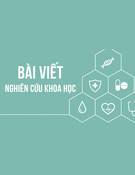

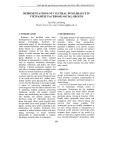
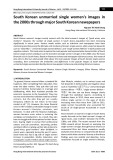

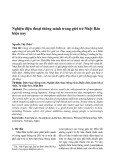
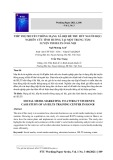

![Bộ quy tắc ứng xử về quấy rối tình dục tại nơi làm việc [Mới nhất]](https://cdn.tailieu.vn/images/document/thumbnail/2021/20210316/angicungduoc10/135x160/9711615879707.jpg)
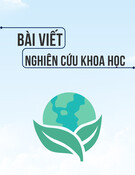

![Sổ tay Hướng dẫn truyền thông về lao động trẻ em [Mới nhất]](https://cdn.tailieu.vn/images/document/thumbnail/2025/20251114/kimphuong1001/135x160/7201763091001.jpg)
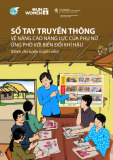
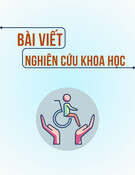





![Cẩm nang Thanh niên hành động [Mới nhất]](https://cdn.tailieu.vn/images/document/thumbnail/2025/20251017/kimphuong1001/135x160/1521760665202.jpg)
